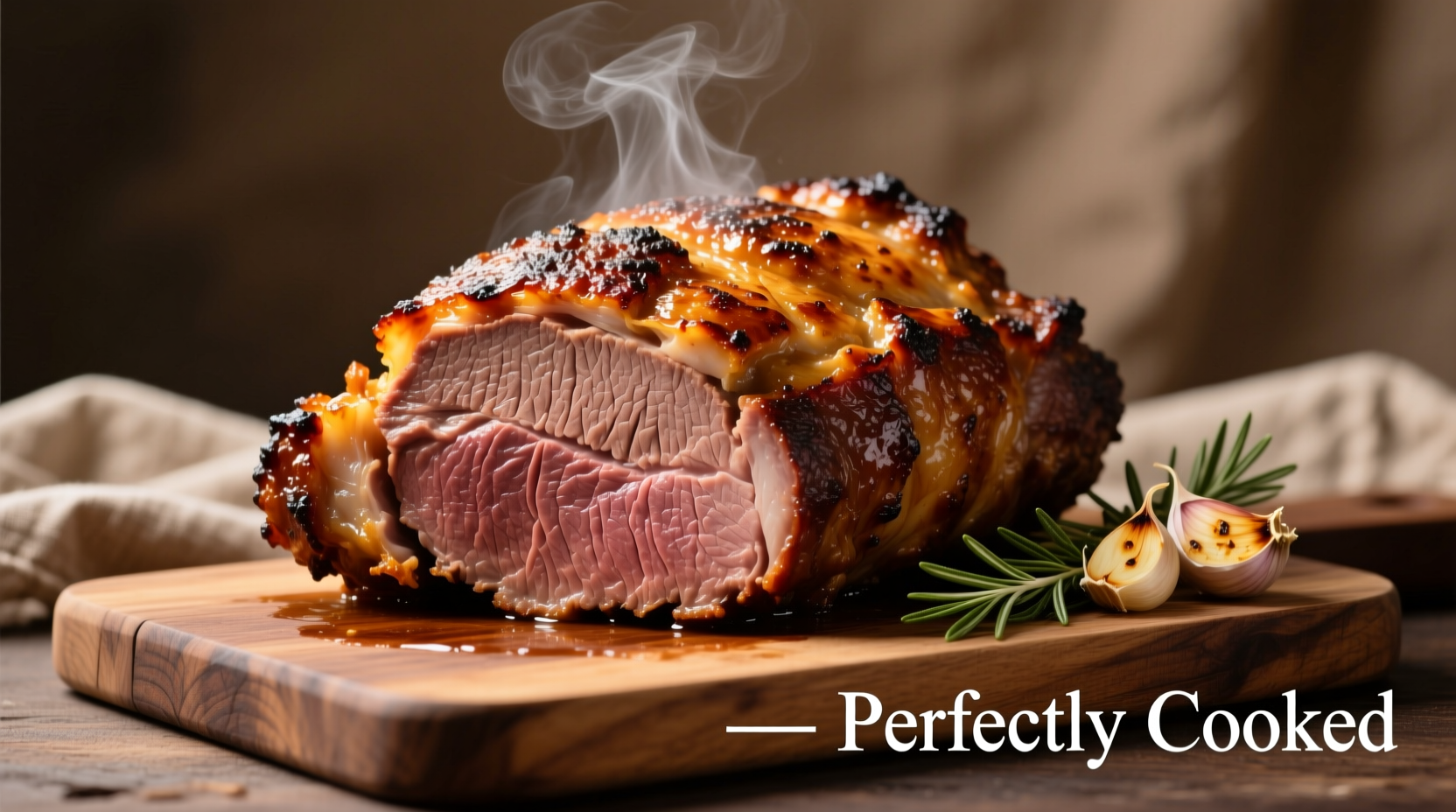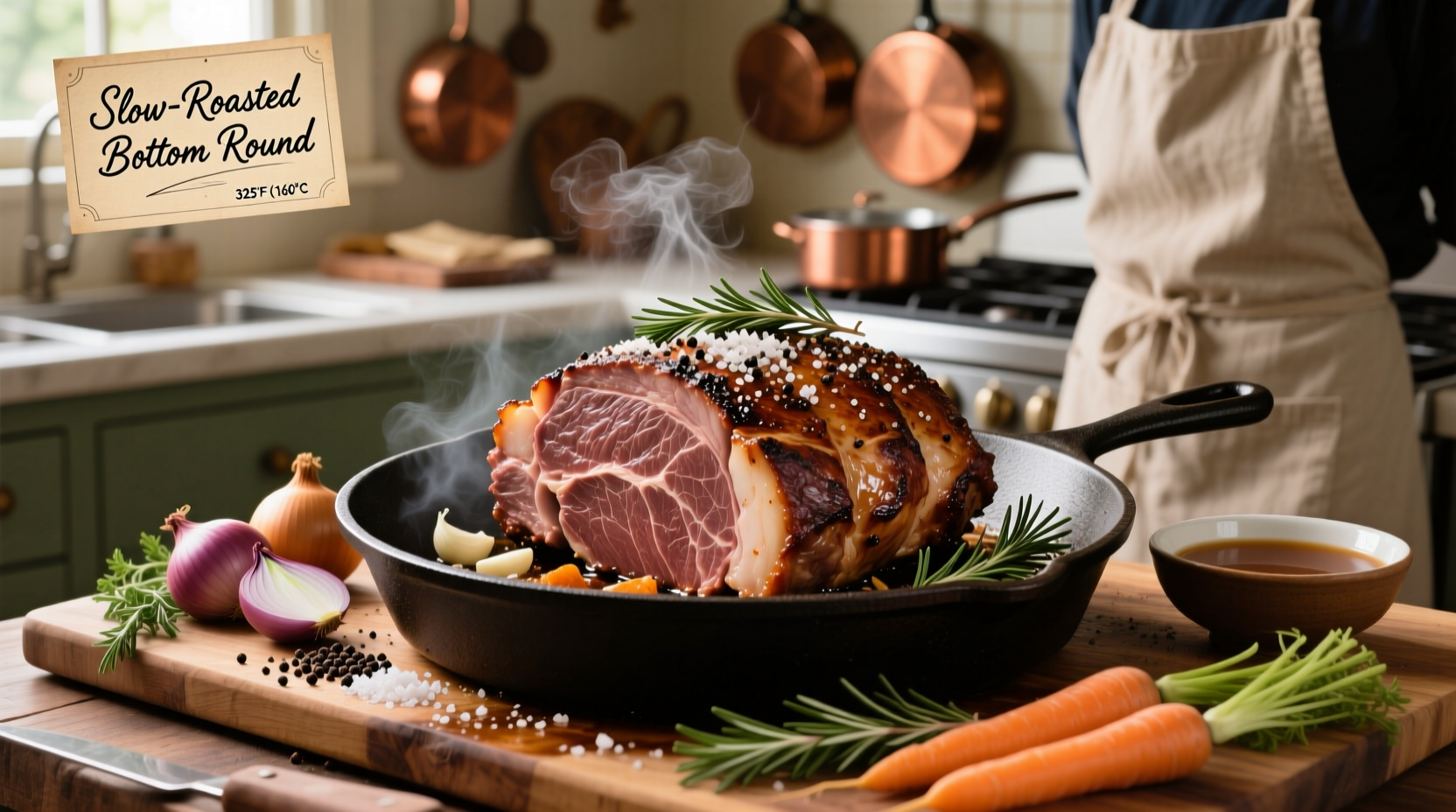Mastering Bottom Round Roast: Your Complete Cooking Guide
If you've ever wondered how to transform this affordable but challenging cut into a tender, flavorful centerpiece, you're in the right place. Bottom round roast comes from the hindquarters of the cow—a well-exercised area that makes this cut lean but potentially tough if not prepared correctly. Unlike more marbled cuts like chuck roast, bottom round requires specific techniques to achieve optimal results without drying out.
Why Bottom Round Roast Deserves Your Attention
This economical cut typically costs 30-40% less than premium roasts but delivers excellent flavor when cooked properly. According to USDA agricultural data, bottom round accounts for nearly 15% of all beef roasts purchased by home cooks seeking budget-friendly options. The challenge? Its low fat content means traditional high-heat roasting often leads to disappointing, dry results.
Understanding Bottom Round Roast Characteristics
Before you start cooking, recognize what makes this cut unique:
- Comes from the rear leg muscle group—one of the hardest-working parts of the animal
- Contains minimal marbling compared to chuck or rib roasts
- Ideally weighs between 2.5-4 pounds for even cooking
- Naturally lean profile makes it perfect for health-conscious cooks
| Cooking Method | Time per Pound | Best Internal Temp | Tenderness Result |
|---|---|---|---|
| Low-Temp Oven Roasting | 25-30 minutes | 130-135°F | Excellent (when sliced properly) |
| High-Heat Roasting | 15-20 minutes | 140°F+ | Poor (often tough) |
| Braising | 45-60 minutes | 195°F+ | Very Good |
| Slow Cooker | 6-8 hours | 190°F+ | Good |
The Temperature Timeline: What Happens Inside Your Roast
Understanding the science behind cooking temperatures prevents common mistakes. As your roast cooks:
- 120°F (49°C): Meat begins to firm slightly; perfect for rare preparation
- 130-135°F (54-57°C): Optimal range for medium-rare; connective tissues start breaking down
- 140°F (60°C): Protein fibers tighten significantly; moisture loss accelerates
- 160°F+ (71°C): Excessive moisture loss; texture becomes dry and stringy
USDA Food Safety and Inspection Service guidelines confirm that cooking beef to 145°F with a 3-minute rest meets safety requirements, but for bottom round specifically, lower temperatures yield better texture results due to its lean nature.
Step-by-Step: Perfect Oven Method for Bottom Round Roast
Preparation Essentials
Proper preparation makes all the difference with this lean cut:
- Bring to room temperature: Remove roast from refrigerator 60-90 minutes before cooking
- Trim strategically: Remove only thick surface fat (¼ inch layer helps flavor development)
- Season generously: Use coarse salt 45 minutes before cooking to enhance moisture retention
- Sear properly: Heat oil to smoking point, then sear all sides for 2-3 minutes per side
The Low-and-Slow Roasting Process
- Preheat oven to 275°F (135°C)—critical for even cooking
- Place roast on rack in roasting pan, bone-side down if applicable
- Insert oven-safe thermometer into thickest part
- Roast until thermometer reads 115-120°F (46-49°C)
- Remove when 5-7°F below target final temperature (carryover cooking will raise it)

Avoiding Common Bottom Round Roast Mistakes
Even experienced cooks make these errors with bottom round:
- Overcooking: This cut dries out quickly above 140°F—use a reliable thermometer
- Skipping the rest: Minimum 15-20 minute rest allows juices to redistribute
- Incorrect slicing: Always cut perpendicular to muscle fibers (against the grain)
- High-heat approach: Traditional 350°F+ roasting leads to uneven results
When Bottom Round Works Best (and When It Doesn't)
Context matters for this versatile cut:
- Ideal for: Sunday dinners, meal prep, sandwiches, and dishes where thin slicing is required
- Not recommended for: Quick weeknight meals (requires 3-4 hours total time), high-heat grilling
- Best paired with: Acidic elements like wine-based marinades or tomato sauces that help tenderize
- Alternative cuts when: You need faster cooking (try top round) or more marbling (chuck roast)
Perfect Slicing Technique: The Final Crucial Step
No matter how perfectly you cook your roast, improper slicing ruins the texture. Follow these steps:
- Identify the direction of muscle fibers (they run lengthwise in bottom round)
- Position your knife perpendicular to these fibers
- Cut thin slices (⅛ to ¼ inch thick)
- Maintain consistent pressure for even slices
This technique shortens the tough muscle fibers, creating a noticeably more tender eating experience.
Storage and Leftover Solutions
Proper handling extends your roast's life:
- Refrigeration: Store in airtight container for up to 4 days
- Freezing: Wrap tightly in freezer paper; use within 3 months
- Reviving leftovers: Slice thinly and warm in beef broth to restore moisture
- Creative uses: Beef stroganoff, roast beef sandwiches, or chopped for tacos
Pro Tips from Professional Kitchens
Adopt these chef-approved techniques:
- Inject the roast with beef broth for added moisture during cooking
- Use a water pan in the oven to maintain humidity
- Add vegetables to the pan during the last 60 minutes for natural au jus
- Consider a brief marinade (4-12 hours) with acidic components like vinegar
Frequently Asked Questions
Can I cook bottom round roast in a slow cooker?
Yes, but with modifications. Sear first, then cook on low for 8-10 hours with 1 cup liquid. The longer cooking time breaks down connective tissue, yielding tender results. Avoid high setting as it makes the meat tough.
Why is my bottom round roast always tough?
This typically happens due to overcooking or improper slicing. Bottom round requires precise temperature control (130-135°F for medium-rare) and must be sliced against the grain. Cooking above 140°F causes rapid moisture loss in this lean cut.
How long should I let bottom round roast rest before slicing?
Rest for 15-20 minutes—minimum 5 minutes per pound. This allows juices to redistribute throughout the meat. Cover loosely with foil to maintain temperature without steaming the crust.
What's the best way to reheat bottom round roast leftovers?
Slice thinly and warm in a skillet with 2 tablespoons beef broth over medium-low heat. This gentle reheating method restores moisture without overcooking. Avoid microwaving which makes the meat rubbery.
Should I marinate bottom round roast before cooking?
A 4-12 hour marinade with acidic components (wine, vinegar, citrus) helps tenderize this lean cut. Avoid longer than 12 hours as acid can make the surface mushy. Dry brining with salt 1-2 hours before cooking also improves moisture retention.











 浙公网安备
33010002000092号
浙公网安备
33010002000092号 浙B2-20120091-4
浙B2-20120091-4